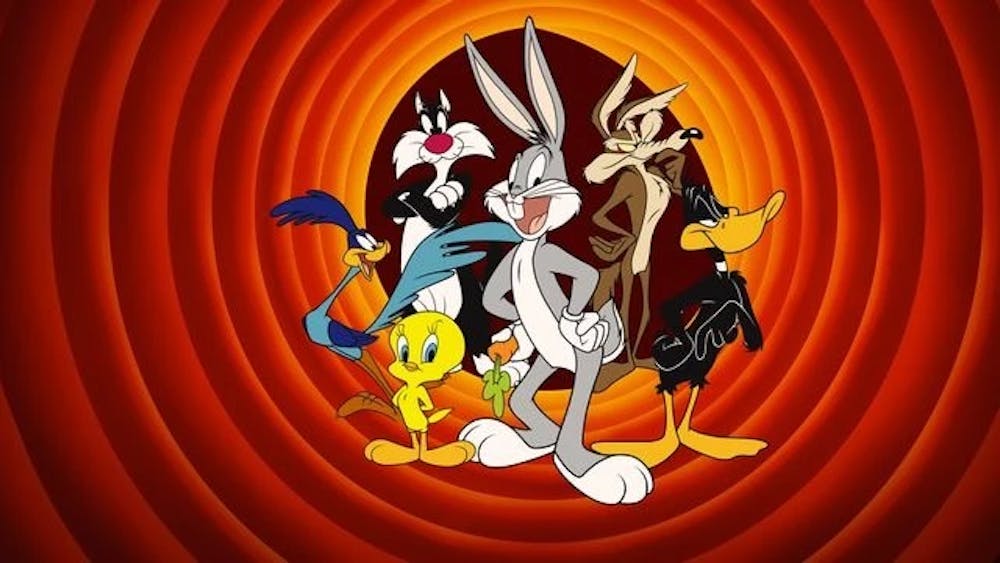Who’s the greatest anthropomorphic cartoon rabbit? That shouldn’t be a difficult question. What about the greatest cartoon duck? The greatest pig, the greatest coyote, the greatest Tasmanian devil? Maybe some answers come to mind. Any show would be lucky to have even one of these characters in their series, but if one show had all of these wacky and zany characters, then it might stand to reason that it’s one of the best shows of all time. I’m glad to say that one show DOES have all these characters, and it is “Looney Tunes.”
Except it’s not exactly a TV show. “Looney Tunes” more broadly refers to the collection of theatrical shorts aired from the 1930s to the 1990s featuring an expansive collection of characters, ranging from Bugs Bunny (my absolute favorite) to Sylvester and Tweety (my least favorite). These shorts spawned a media empire, and these characters have done everything from exploring space to playing basketball with Michael Jordan and LeBron James. This cinematic universe is diverse in the stories they tell and shows a willingness to experiment with the scenarios that they put their characters in.
“Looney Tunes” has something for everyone. Do you want to watch Bugs Bunny get unjustly drafted to fight in the US Army and wreak havoc in training camp? Then watch “Forward March Hare” (1952). Do you wanna watch Daffy escape the draft? Then watch “Draftee Daffy” (1945). Do you wanna watch Bugs Bunny lose his marbles because he didn’t get nominated for an Academy Award? Then watch “What’s Cookin’ Doc?” (1944). Do you want to see Daffy fly in the air and migrate north for the winter (since he is a duck, after all)? Then watch “Daffy Flies North” (1980).
What’s brilliant about “Looney Tunes” is that it doesn’t shoot itself in the foot by tying its characters to specific archetypes. Bugs Bunny is not only a rabbit, but he is a professional piano player, an opera singer, an inventor, a knight and a superhero, among others. Daffy isn’t just a duck, but he is also an insurance salesman, flight attendant, city council member, conman, hairdresser and a convicted felon.
If you don’t like one specific “Looney Tunes” episode or short, then there are a million other “Looney Tunes” properties for you to enjoy. The formulaic nature of television writing is a flaw that drags down many other cartoons of its era, such as“Tom and Jerry.” While a couple of episodes are worth a chuckle, the formula of “cat chases mouse” gets a little repetitive. “Looney Tunes” pretty much does this same formula with their Sylvester and Tweety shorts, wherein Sylvester the Cat tries to kill Tweety Bird in cold blood, all while their owner, Granny, is oblivious. If the Sylvester and Tweety shorts comprised the entirety of “Looney Tunes,” then I wouldn’t be a fan. But, luckily for me, it’s only one genre of “Looney Tunes” shorts. There are so many characters, and it’s hard to pick a favorite. Marvin the Martian, Michigan J. Frog, Melissa Duck, Elmer Fudd, Foghorn Leghorn, Gossamer, Yosemite Sam, Speedy Gonzales, Lola Bunny. The “Looney Tunes” universe is expansive and ripe with charismatic characters.
It’s also fair to say that these cartoons wouldn’t be as memorable without their groundbreaking animation direction. The theatrical shorts gave the opportunity to influential directors like Tex Avery and Chuck Jones to push the animation industry further. They each brought their own vision to the characters, making the show much better than before they both took the reigns. Tex Avery was responsible for shaping the early theatrical shorts away from Disney-knockoffs, and more towards a sarcastic, slapstick-heavy tone that’s familiar to viewers today. Chuck Jones was particularly influential in the level of high-quality artistry that permeated each short. Cartoons directed by Chuck Jones can be characterized by the vibrancy of the colors in each frame and the smoothness and complexity of its character animation. Visual gags were rampant, yet they were not the only reason to watch Jones’ shorts, as they maintained a level of high-brow humor and high-art influence. The characters move with elegance and the writing is nonsensically brilliant. Jones shaped much of what would become the “Looney Tunes” and he directed a lot of my favorite shorts.
This comes with a massive disclaimer, however. It’s important to mention that the “Looney Tunes” serves as a time capsule. I would be remiss if I didn’t mention many of the racist shorts from the 1920s to the 1940s. These shorts, dubbed the “censored eleven,” are eleven shorts pulled from syndication by Warner Bros. since 1968 for inclusion of racial and ethnic stereotypes. Even outside of the “censored eleven,” many of the early shorts feature racist gags and offensive stereotypes. When distributing old “Looney Tunes” and “Tom and Jerry” shorts on DVD, Warner Bros. issued a disclaimer stating that these cartoons are “products of their time” and that the stereotypes featured were “wrong then and wrong today.” The early shorts are aired unedited, however, because Warner Bros. claimed that editing them out would be “the same as denying that the stereotypes existed.” It’s important to contextualize the historical significance of these shorts, as they hold a mirror up to our nation’s history, and reckoning with this history is an important task.
Despite its problematic past, “Looney Tunes” has evolved throughout the latter half of the 20th century to become a cultural icon and the epitome of animated greatness. From the goofy antics of the theatrical shorts to the surreal nature of “Space Jam,” the show’s expansive universe is a testament to its creative excellence. Characters like Bugs and Daffy cheer you up when you’re down, and Chuck Jones’ brilliant direction will entertain you for hours. It’s safe to say that “Looney Tunes” truly is the best to ever do it.
Get The Chronicle straight to your inbox
Signup for our weekly newsletter. Cancel at any time.

